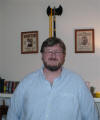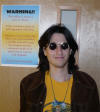Summit-Sim featured in KSUA Campus Newsletter (Page 4.)
Click here to see video from our presentation at the 2nd Annual Student Academic Conference
Click here to download the latest version of Summit-Sim.
Click here for older versions of Summit-Sim.
For this class, we are using several different methods to analyze socio-economic data gathered about the population of Summit County, Ohio. These methods include Network Analysis, Agent-Based Modeling, Neural Networking, and Data Mining.
Michael Ball (me) and Kenneth Carvalho chose to focus on the Agent-Based Modeling aspect. What follows is a summary of our progress so far.
Together, we have written a Visual Basic program that allows us to model neighborhood grouping based on level of wealth. Our program is based on Schelling's Segregation Model, with some variations in the rule set to more closely mimic the conditions in Summit County. The rule set for our program was discussed by the entire class and went through several revisions before reaching agreement on the final form for the rules.
Kenny and I are planning on continuing the development of this program. As newer versions are completed, we will make them available on this site.
8/24/08 - Summit-Sim Ver. 3.0 Final
Ver. 3.0 will be the final version of Summit-Sim. We have decided to attempt to duplicate Summit-Sim under a new programming platform. We are currently working with NetLogo. This move with allow us to verify that our results are not a programming artifact and also make further development easier.
To see what's going on with the new model - check my Pareto-Schelling page.
4/25/08 - Summit-Sim presented at 2nd Annual Student Academic Conference at Kent State University - Stark Campus
Kenny and I were proud to be accepted as presenters at the conference. The presentation and our program were well received. We would like to thank everyone who attended our session. Many of the comments we received about the program have given us new directions for further development of Summit-Sim.
Embedded below are two video clips from our presentation:
Summit-Sim Presentation Part 1.
Summit-Sim Presentation Part 2.
Summit-Sim Ver. 3.0 Beta completed 11/29/07
New for this version:
The user can now save an agent configuration to a text file and reload it at a later time. Also, a progress bar has been added so that the user can track the program's progress on longer iteration runs.
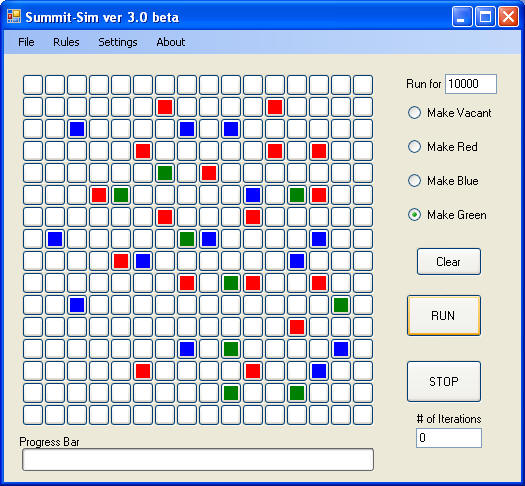
Clean-up of the code continues and Kenny is working on modularizing the program to make future development easier.
The next step will be to further develop the save/load function to include custom rule sets. We are also looking at the possibility of multiple grid sizes.
Summit-Sim ver. 3.0 was developed and written using Microsoft Visual Studio 2005 Professional in a Visual Basic Environment. The complete solution file and folders for version 3.0 can be downloaded in zipped format here.
Summit-Sim Ver. 2.0 completed 11/28/07
New for this version:
We have added the ability to dynamically change the movement and happiness rules for the agents. Click on Settings to display the new rule controls. The movement and happiness rules can be changed without clearing the board, allowing the user to see the groupings break up and re-form according to the new rules.
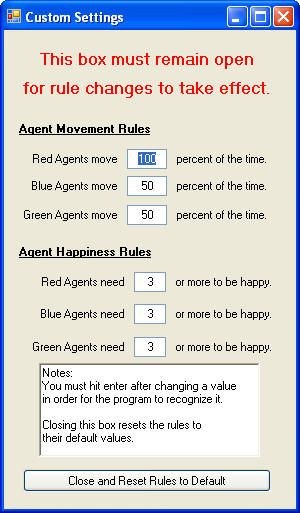
Also, a minor bug-fix for this version. The iteration count display was fixed so that it shows the total iterations run on the board. Now, only the Clear button will reset the iteration count.
Summit-Sim ver. 2.0 was developed and written using Microsoft Visual Studio 2005 Professional in a Visual Basic Environment. The complete solution file and folders for version 2.0 can be downloaded in zipped format here.
Summit-Sim Ver. 1.0 completed 11/13/07
Our first working version of the program was completed on 11/13/07 and was presented to the class the next day.
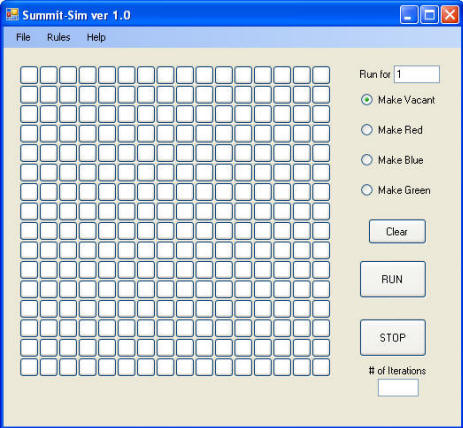
The program has a 16x16 grid, giving us a total of 256 locations that an agent can occupy. To set up the initial distribution of agents, the user can select the Make (color) radio button of their choice and then click grid squares to change that grid position to the selected color.
The colors represent the following socio-economic groups: Red Agents are Upper Class, Blue Agents are Middle Class and Green Agents are Lower Class.
The rule set for the agents:
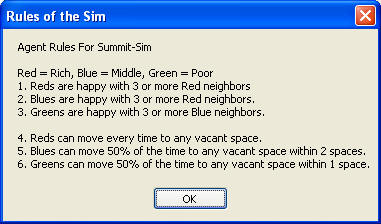
When the RUN button is clicked the program will run for the number of iterations indicated in the "run for" box. One iteration will check the happiness of all of the 256 agent positions and make the appropriate movement for any un-happy agents.
The CLEAR button will clear the board, setting all agent positions to vacant.
If you would like to try Summit-Sim ver. 1.0 for yourself, you can download a copy here.
For a MS Word document containing the code for Summit-Sim ver. 1.0, click here.
Summit-Sim ver. 1.0 was developed and written using Microsoft Visual Studio 2005 Professional in a Visual Basic Environment. The complete solution file and folders for version 1.0 can be downloaded in zipped format here.
If you would like to try Summit-Sim ver. 2.0 for yourself, you can download a copy here.
Summit-Sim ver. 2.0 was developed and written using Microsoft Visual Studio 2005 Professional in a Visual Basic Environment. The complete solution file and folders for version 2.0 can be downloaded in zipped format here.
